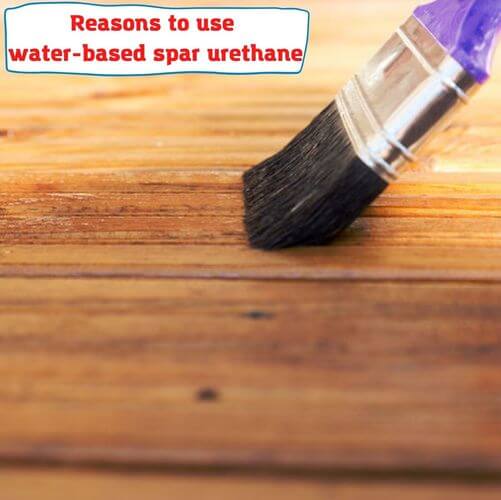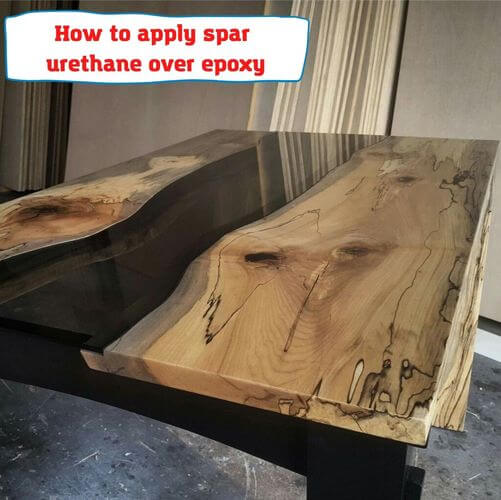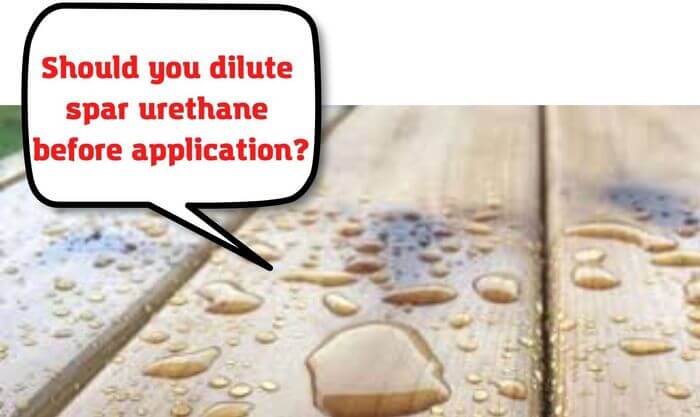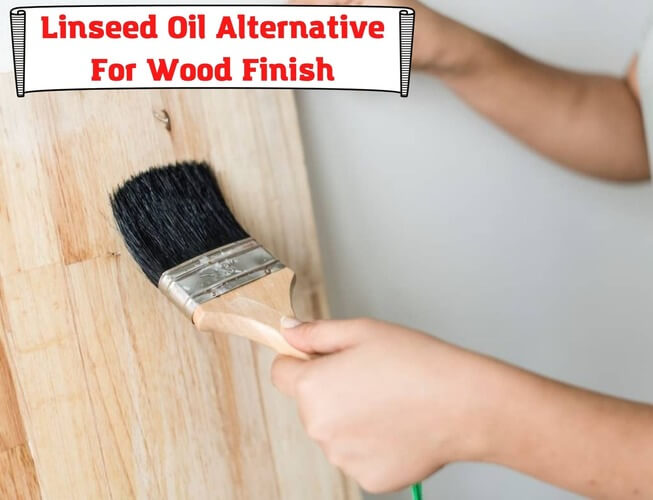
Applying spar urethane over epoxy offers a reliable, sturdy, and nearly unbreakable coat, making it one of the most preferred wood finishes. That is because spar urethane contains special ultraviolet inhibitors that prevent discoloration, damage, and fading from extended sun exposure. In addition, applying varnish delivers a warm and natural amber wood tone that can enhance the appearance of stained or bare wood projects. Discover the top tips to remember before using spar urethane over epoxy here below.
Why should you apply spar urethane over epoxy?
- Sealing epoxy with spar urethane protects it from the fading and graying effects of the sun.
- The special oils in spar urethane allow the final finish to contract and expand with the wood to avoid cracks as temperatures and seasons change.
- Applying three epoxy coats followed by at least three spar urethane coats can produce the same look and depth of more than 12 coats of regular varnish.
- Spar urethane also builds thickness much faster in every new layer, and it does not shrink after curing.
- Spar urethane forms a durable protective barrier to prevent moisture, rain, and water damage.
- It provides a visually appealing natural amber tone that enhances the finish.
- Self-leveling spar urethane is easy to use and apply over epoxy without any hassles, and it is ideal for both exterior and interior wood-care projects.
- The advanced spar urethane outshines other epoxy finishes since it resists peeling and cracking, protecting the wood over the long term.
Should you use water-based or oil-based spar urethane?
Before you can apply spar urethane, a critical consideration is to choose between the water-based version and the oil-based one. Here are a few pros of each type to help you decide.
Reasons to use oil-based spar urethane
It looks better
The oil-based version of spar urethane provides more depth in shine and color, thus providing a better final result. In contrast, the water-based one typically offers a duller and more toned-down finish. Furthermore, the oil-based varnish gets a richer, amber look over time while its counterpart gets softer with time.
It costs less
Applying oil-based spar urethane is cheaper, and you will typically pay between 10% and 25% less. In addition, you will also benefit from a longer-lasting finish, which means you won’t have to redo the wood or furniture more often.
It lasts longer
Oil-based spar urethane has higher amounts of volatile organic compounds, which enable it to last longer than water-based urethane. The water-based varnish is also thinner, and it requires at least five coats to achieve similar durability as applying three coats of oil-based urethane. Hence, if you want a durable option, it is best to choose the oil-based varnish.
Reasons to use water-based spar urethane

It dries faster
The most significant advantage of applying water-based spar urethane is that it dries faster. This option makes it ideal for commercial applications like stores and restaurants where longer drying times may affect the business operations.
It is eco-friendly
There are fewer VOCs in water polyurethane, which makes it eco-friendlier. It is worth noting that this eco-friendly benefit only applies during drying. Once the spar urethane is completely dry, there are no differences in off-gassing, smell, etc.
It does not smell too bad
While both versions of spar urethane smell, the water-based one has a slightly less infuriating scent during application. Nevertheless, it is always best to stay at a different place while the varnishing work is done.
How to apply spar urethane over epoxy

Here is a simple step-by-step procedure to guide you when applying spar urethane over epoxy. When dealing with these tasks, remember to work in an open or well-ventilated area.
Prepare the worksite
Get rid of dirt and dust before starting working on the wood. All working surfaces must be clean to avoid dust contaminating and blemishes to the wood.
Make sure you have adequate lighting
Spar urethane offers a clear varnished finish, which means you must set up extra lighting to check for imperfections.
Prepare the wood
Use sandpaper to remove old varnish or coatings to make the wood even smooth. Finally, use a wet cloth or vacuum cleaner to get rid of dust.
Apply the epoxy resin
Start with some epoxy primers before applying the epoxy resin. Give it at least one day to dry, and then let it rest and cure to create a stable foundation for the spar urethane.
Apply the first coat of spar urethane
Once the epoxy has cured, you can now apply the first coat of spar urethane. You can either spray, wipe or brush the spur urethane onto the wood.
Sand the first coat
Take fine-grit sandpaper and sand down the first coat once thoroughly dried. Ensure to use wet sanding to preserve the spar urethane and avoid damaging it.
Thin the spar urethane
Once the first spar urethane coat has dried, you can now consider thinning the varnish. Mix one part of mineral spirits with two parts oil-based spar thinner.
Apply two more coats
Use your preferred application method and apply at least two more coats of the oil-based varnish and roughly three more for the water-based one. Allow at least a day of sufficient drying time, and then you can sand and apply the next spar urethane coat.
Polish the wood surface
After two days, the final step is to polish the last layer of spar urethane to create a fantastic result. That is the best time to eliminate any scratches and make the wood surface shiny and appealing.
Should you dilute spar urethane before application?

Whether it is an indoor or outdoor formula, spar urethane requires a bit of finesse to ensure no brush strokes or bubbles remain when you apply it. Even if you use the best brushes or proper technique, it is easy to get imperfections and brush marks in the final finish. The main issue with applying spar urethane is that it’s thicker than regular varnish.
One method of significantly enhancing your spar urethane’s workability before applying over epoxy is thinning it by adding mineral spirits. Diluting the urethane by between 10% and 20% helps you make brushing considerably easier. In addition, thinning the urethane further would allow for spraying application.
Thinning the spar urethane allows the varnish to better self-level, which will prevent brush marks. However, the only drawback of thinning your varnish is that you will require applying a few more coats before achieving the ideal film thickness without any blemishes.
Should you sand spar urethane between coats?
Sanding plays a key role when applying spar urethane over epoxy. To ensure the next urethane coat can stick, you must sand the finish between every layer. Sanding creates a rough surface to enhance adhesion and create a tighter mechanical bond between the epoxy and spar urethane. Moreover, sanding helps to eliminate imperfections like bubbles and brush strokes from the surface to give you a more appealing outcome.
Seal screw holes with epoxy
Keeping the moisture and water out of wood is essential for any woodworking job. That means applying sufficient epoxy resins to all screw holes before running the screws in place. You must seal all screw holes using epoxy to avoid thermal cycling.
Thermal cycling can cause moisture to seep into the wood through the screw holes. Once the water enters the wood, it causes the surface to discolor and swell, which results in the varnish cracking, lifting, and peeling. The solution is to add a couple of drops of the epoxy into all the screw holes before inserting the screws. That way, you can prevent any water from seeping into the wood.
Is spar urethane toxic?
Spar urethane is toxic. There are several safety guidelines that you must follow to ensure that everyone within the product’s vicinity is safe. For instance, you should not apply spar urethane around kids or pets, particularly if you want to use the oil-based version. In contrast, the water-based one produces less toxic gases and is ideal for residential usage. Nevertheless, once the spar urethane has completely cured, usually after at least 30 days, then it is safe.
Conclusion
The main thing to remember if you are planning to use a combination of epoxy and spar urethane finish is to be as thorough as possible. If you are not keen when applying either the epoxy or the spar urethane, then it is likely that moisture will get into the wood. If that happens, it will result in premature coating failure or a high probability of rot.
However, if you use the tips mentioned above and ensure that moisture is kept away from the wood, you can get great results by applying spar urethane over epoxy. The best feature of using spar urethane is that it significantly reduces the total effort and resources necessary for maintaining wood surfaces over time. It creates a durable, washable, and attractive surface that can better tolerate harsh weather conditions while maintaining a natural shine.
- Can You Unmix Paint: Techniques, Consequences, Alternatives - February 23, 2024
- Does Primer Need to be Mixed? Effective Primer Application - February 22, 2024
- How to Make Old Paint Usable Again: Retrieving and Preserving Paint - February 21, 2024



